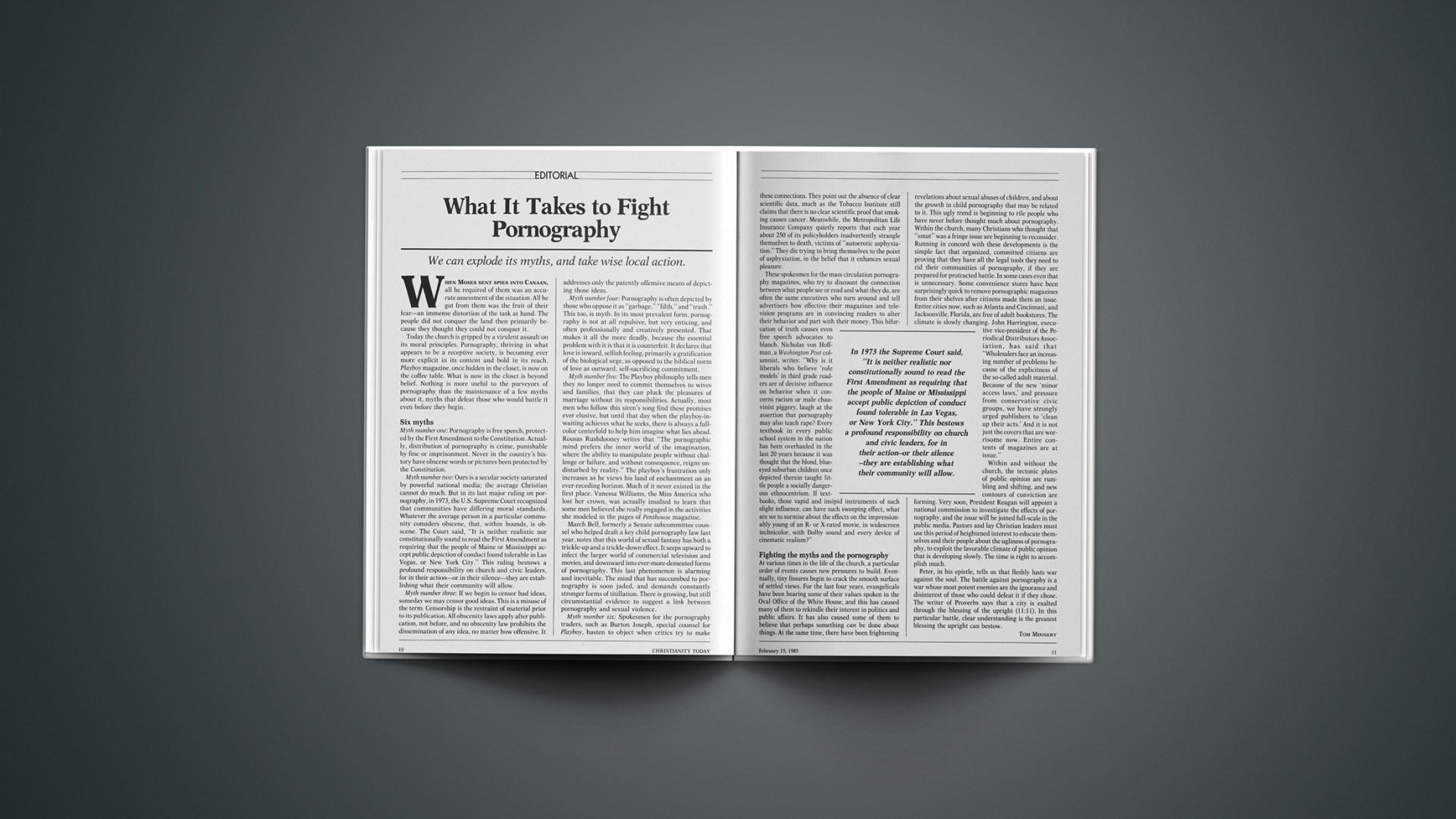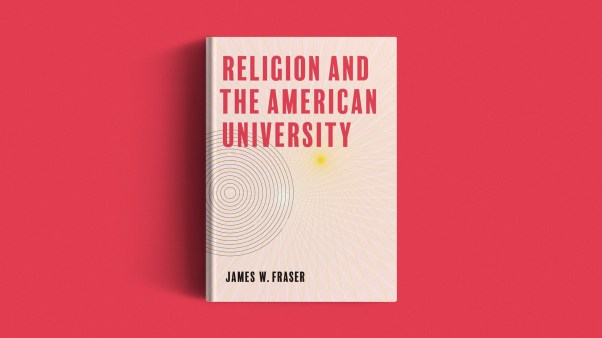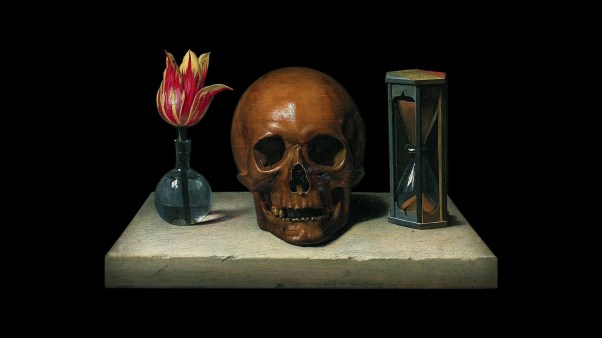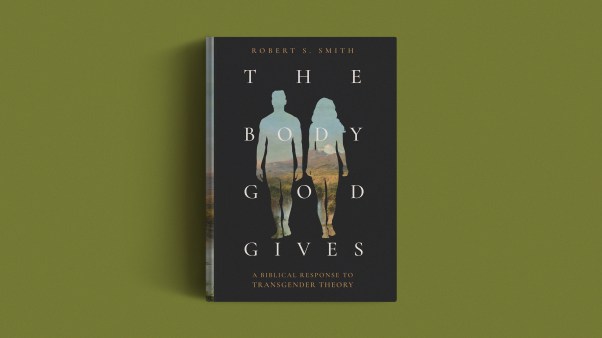We can explode its myths, and take wise local action.
When Moses sent spies into Canaan, all he required of them was an accurate assessment of the situation. All he got from them was the fruit of their fear—an immense distortion of the task at hand. The people did not conquer the land then primarily because they thought they could not conquer it.
Today the church is gripped by a virulent assault on its moral principles. Pornography, thriving in what appears to be a receptive society, is becoming ever more explicit in its content and bold in its reach. Playboy magazine, once hidden in the closet, is now on the coffee table. What is now in the closet is beyond belief. Nothing is more useful to the purveyors of pornography than the maintenance of a few myths about it, myths that defeat those who would battle it even before they begin.
Six Myths
Myth number one: Pornography is free speech, protected by the First Amendment to the Constitution. Actually, distribution of pornography is crime, punishable by fine or imprisonment. Never in the country’s history have obscene words or pictures been protected by the Constitution.
Myth number two: Ours is a secular society saturated by powerful national media; the average Christian cannot do much. But in its last major ruling on pornography, in 1973, the U.S. Supreme Court recognized that communities have differing moral standards. Whatever the average person in a particular community considers obscene, that, within bounds, is obscene. The Court said, “It is neither realistic nor constitutionally sound to read the First Amendment as requiring that the people of Maine or Mississippi accept public depiction of conduct found tolerable in Las Vegas, or New York City.” This ruling bestows a profound responsibility on church and civic leaders, for in their action—or in their silence—they are establishing what their community will allow.
Myth number three: If we begin to censor bad ideas, someday we may censor good ideas. This is a misuse of the term. Censorship is the restraint of material prior to its publication. All obscenity laws apply after publication, not before, and no obscenity law prohibits the dissemination of any idea, no matter how offensive. It addresses only the patently offensive means of depicting those ideas.
Myth number four: Pornography is often depicted by those who oppose it as “garbage,” “filth,” and “trash.” This too, is myth. In its most prevalent form, pornography is not at all repulsive, but very enticing, and often professionally and creatively presented. That makes it all the more deadly, because the essential problem with it is that it is counterfeit. It declares that love is inward, selfish feeling, primarily a gratification of the biological urge, as opposed to the biblical norm of love as outward, self-sacrificing commitment.
Myth number five: The Playboy philosophy tells men they no longer need to commit themselves to wives and families, that they can pluck the pleasures of marriage without its responsibilities. Actually, most men who follow this siren’s song find these promises ever elusive, but until that day when the playboy-in-waiting achieves what he seeks, there is always a full-color centerfold to help him imagine what lies ahead. Rousas Rushdooney writes that “The pornographic mind prefers the inner world of the imagination, where the ability to manipulate people without challenge or failure, and without consequence, reigns undisturbed by reality.” The playboy’s frustration only increases as he views his land of enchantment on an ever-receding horizon. Much of it never existed in the first place. Vanessa Williams, the Miss America who lost her crown, was actually insulted to learn that some men believed she really engaged in the activities she modeled in the pages of Penthouse magazine.
March Bell, formerly a Senate subcommittee counsel who helped draft a key child pornography law last year, notes that this world of sexual fantasy has both a trickle-up and a trickle-down effect. It seeps upward to infect the larger world of commercial television and movies, and downward into ever-more-demented forms of pornography. This last phenomenon is alarming and inevitable. The mind that has succumbed to pornography is soon jaded, and demands constantly stronger forms of titillation. There is growing, but still circumstantial evidence to suggest a link between pornography and sexual violence.
Myth number six: Spokesmen for the pornography traders, such as Burton Joseph, special counsel for Playboy, hasten to object when critics try to make these connections. They point out the absence of clear scientific data, much as the Tobacco Institute still claims that there is no clear scientific proof that smoking causes cancer. Meanwhile, the Metropolitan Life Insurance Company quietly reports that each year about 250 of its policyholders inadvertently strangle themselves to death, victims of “autoerotic asphyxiation.” They die trying to bring themselves to the point of asphyxiation, in the belief that it enhances sexual pleasure.
These spokesmen for the mass circulation pornography magazines, who try to discount the connection between what people see or read and what they do, are often the same executives who turn around and tell advertisers how effective their magazines and television programs are in convincing readers to alter their behavior and part with their money. This bifurcation of truth causes even free speech advocates to blanch. Nicholas von Hoffman, a Washington Post columnist, writes: “Why is it liberals who believe ‘role models’ in third grade readers are of decisive influence on behavior when it concerns racism or male chauvinist piggery, laugh at the assertion that pornography may also teach rape? Every textbook in every public school system in the nation has been overhauled in the last 20 years because it was thought that the blond, blue-eyed suburban children once depicted therein taught little people a socially dangerous ethnocentrism. If textbooks, those vapid and insipid instruments of such slight influence, can have such sweeping effect, what are we to surmise about the effects on the impressionably young of an R- or X-rated movie, in widescreen technicolor, with Dolby sound and every device of cinematic realism?”
Fighting The Myths And The Pornography
At various times in the life of the church, a particular order of events causes new pressures to build. Eventually, tiny fissures begin to crack the smooth surface of settled views. For the last four years, evangelicals have been hearing some of their values spoken in the Oval Office of the White House, and this has caused many of them to rekindle their interest in politics and public affairs. It has also caused some of them to believe that perhaps something can be done about things. At the same time, there have been frightening revelations about sexual abuses of children, and about the growth in child pornography that may be related to it. This ugly trend is beginning to rile people who have never before thought much about pornography. Within the church, many Christians who thought that “smut” was a fringe issue are beginning to reconsider. Running in concord with these developments is the simple fact that organized, committed citizens are proving that they have all the legal tools they need to rid their communities of pornography, if they are prepared for protracted battle. In some cases even that is unnecessary. Some convenience stores have been surprisingly quick to remove pornographic magazines from their shelves after citizens made them an issue. Entire cities now, such as Atlanta and Cincinnati, and Jacksonville, Florida, are free of adult bookstores. The climate is slowly changing. John Harrington, executive vice-president of the Periodical Distributors Association, has said that “Wholesalers face an increasing number of problems because of the explicitness of the so-called adult material. Because of the new ‘minor access laws,’ and pressure from conservative civic groups, we have strongly urged publishers to ‘clean up their acts.’ And it is not just the covers that are worrisome now. Entire contents of magazines are at issue.”
Within and without the church, the tectonic plates of public opinion are rumbling and shifting, and new contours of conviction are forming. Very soon, President Reagan will appoint a national commission to investigate the effects of pornography, and the issue will be joined full-scale in the public media. Pastors and lay Christian leaders must use this period of heightened interest to educate themselves and their people about the ugliness of pornography, to exploit the favorable climate of public opinion that is developing slowly. The time is right to accomplish much.
Peter, in his epistle, tells us that fleshly lusts war against the soul. The battle against pornography is a war whose most potent enemies are the ignorance and disinterest of those who could defeat it if they chose. The writer of Proverbs says that a city is exalted through the blessing of the upright (11:11). In this particular battle, clear understanding is the greatest blessing the upright can bestow.










